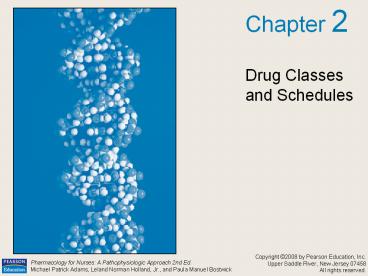Drug Classes PowerPoint PPT Presentation
1 / 36
Title: Drug Classes
1
Chapter 2
Drug Classes and Schedules
2
Drug Are Organized in Two Ways
- Therapeutic classification
- Pharmacologic classification
3
Therapeutic Classification of Drugs
- Based on what the drug does clinically
- Examples
- Anticoagulants
- Antidepressants
- Antineoplastics
4
Pharmacologic Classification of Drugs
- Based on how the drug produces its effect
- At molecular, tissue, or body-system level
- More specific than therapeutic classification
- Requires understanding of biochemistry and
physiology
5
Examples
- Calcium-channel blockers
- Angiotensin-converting enzyme inhibitors
- Proton-pump inhibitors
6
Prototype DrugServes as Model for a Drug Class
- Is well understood
- Has known action and adverse effects
- Is used to compare other drugs in same
pharmacologic class
7
Newer drugs in same class
- Newer drugs in same class may have replaced its
use because they - Are more effective
- Have more favorable safety profile
- Have longer duration of action
8
Mechanism of Action
- How a drug produces its effect in the body
9
Most Drugs Have Three Names
- Chemical
- Generic
- Trade
10
Drug Has One Chemical Name
- Assigned using standard nomenclature established
by International Union of Pure and Applied
Chemistry (IUPAC) - Describes physical and chemical properties of drug
11
Drug Has One Chemical Name
- Complicated, difficult to remember and pronounce
- Example chemical name for diazepam 7-chloro-1,
3-dihydro-1-methyl-5- phenyl-2H-1,
4-benzodiazepin-2-one
12
Drug Classification
- Drugs are sometimes classified by a portion of
their chemical structure - Cephalosporins, phenothiazines, benzodiazepines
13
A Drug Has One Generic Name
- Assigned by the US Adopted Name Council
- Less complicated and easier to remember
- Describes active ingredients
14
A Drug Has One Generic Name
- Used by many organizations
- Food and Drug Administration (FDA)
- US Pharmacopoeia
- World Health Organization
- Written in lower case
- Example diazepam
15
A Drug Has Several Trade Names
- Assigned by company marketing the drug
- Short, easy to remember
- Also called proprietary, product, or brand name
- Drug developer has exclusive rights to name and
market a new drug for 17 years in US. - Trade name is capitalized
- Example trade name for diazepam is Valium
16
A Drug Has One Generic Name
- Assigned by the US Adopted Name Council
- Less complicated and easier to remember
17
Communication Enhanced
- Health-care providers and other health
organizations use generic names - Written in lower case
18
Some States Have a Negative Formulary List
- List of trade-name drugs that pharmacists may not
dispense as generic-drug substitutes - Claim there are differences in bioavailability
between generic and trade-name drugs - Pharmaceutical Companies and Some Health-Care
Practitioners Support List - Claim differences could adversely affect patient
outcomes
19
Controlled Substances Are Drugs That
- Are frequently abused
- Have a high potential for addiction or dependence
- Physical dependence
- Psychological dependence
- Have restricted use
- Are placed into one of five schedules
20
Not All Drugs with Abuse Potential Are Regulated
- Tobacco, alcohol, and caffeine
21
Controlled Substance Act of 1970
- Also known as Comprehensive Drug Abuse Prevention
and Control Act - Restricts use of drugs with potential for abuse
- Restricted drugs placed into five schedules
- Hospitals and pharmacies must maintain complete
records of scheduled drugs
22
Schedule II Drugs Have More Restrictions
- Need special order form to obtain
- Orders must be written
- Orders must be signed by health-care provider
- Telephone orders to pharmacies not permitted
- No refills permitted
- Client must see health-care provider first
23
Controlled Substances
- Anyone Convicted of Unlawful Manufacturing,
Distributing, and Dispensing of Controlled
Substances Faces Severe Penalties
24
Drug Enforcement Administration (DEA) Regulates
Controlled Substance Act
- Hospitals and pharmacies must register with DEA
- Must use assigned registration number to purchase
scheduled drugs
25
Schedule I Drugs
- Highest abuse potential
- High physical and psychological dependence
- Limited or no therapeutic use
26
Examples of Schedule I Drugs
- Heroin
- LSD
- Methaqualone
27
Schedule II Drugs
- High abuse potential
- High physical and psychological dependence
- Therapeutic use with prescription
- Some drugs no longer used
28
Examples of Schedule II Drugs
- Morphine
- PCP
- Cocaine
- Methadone
- Methamphetamine
29
Schedule III Drugs
- Moderate abuse potential
- Moderate physical dependence
- High psychological dependence
- Therapeutic use with prescription
30
Examples of Schedule III Drugs
- Anabolic steroids
- Codeine with aspirin or Tylenol
- Hydrocodone with aspirin or Tylenol
- Some barbiturates
31
Schedule IV Drugs
- Lower abuse potential
- Lower physical and psychological dependence
- Therapeutic use with prescription
32
Examples of Schedule IV Drugs
- Dextropropoxyphene
- Pentazocine
- Meprobamate
- Diazepam
- Alprazolam
33
Schedule V Drugs
- Lowest abuse potential
- Lowest physical and psychological dependence
- Therapeutic use without prescription
- Examples
- OTC cough medicines with codeine
34
Part III, Schedule G, of Canadian Food and Drugs
Act
- Controlled substances only dispensed for specific
conditions and diseases - Drugs must be labeled with letter C on outside
of container - Examples
- Amphetamines
- Barbiturates
- Methaqualone
- Anabolic steroids
35
Part IV, Schedule H, of Canadian Food and Drugs
Act
- Restricted drugs not intended for human use
- Drugs used in chemical or analytical procedure
- Medical, laboratory industrial, educational, or
research purposes - Restricted drugs, such as
- LSD
- MDMA
- DOM (street name, STP)
36
Schedule F Drugs, Canadian Narcotic Control Act
and Amended Schedules
- Require prescription
- Include
- Methylphenidate (Ritalin)
- Diazepam (Valium)
- Chlordiaepoxide (Librium)
- Narcotic drugs must be labeled with the letter N
on the outside of the container

